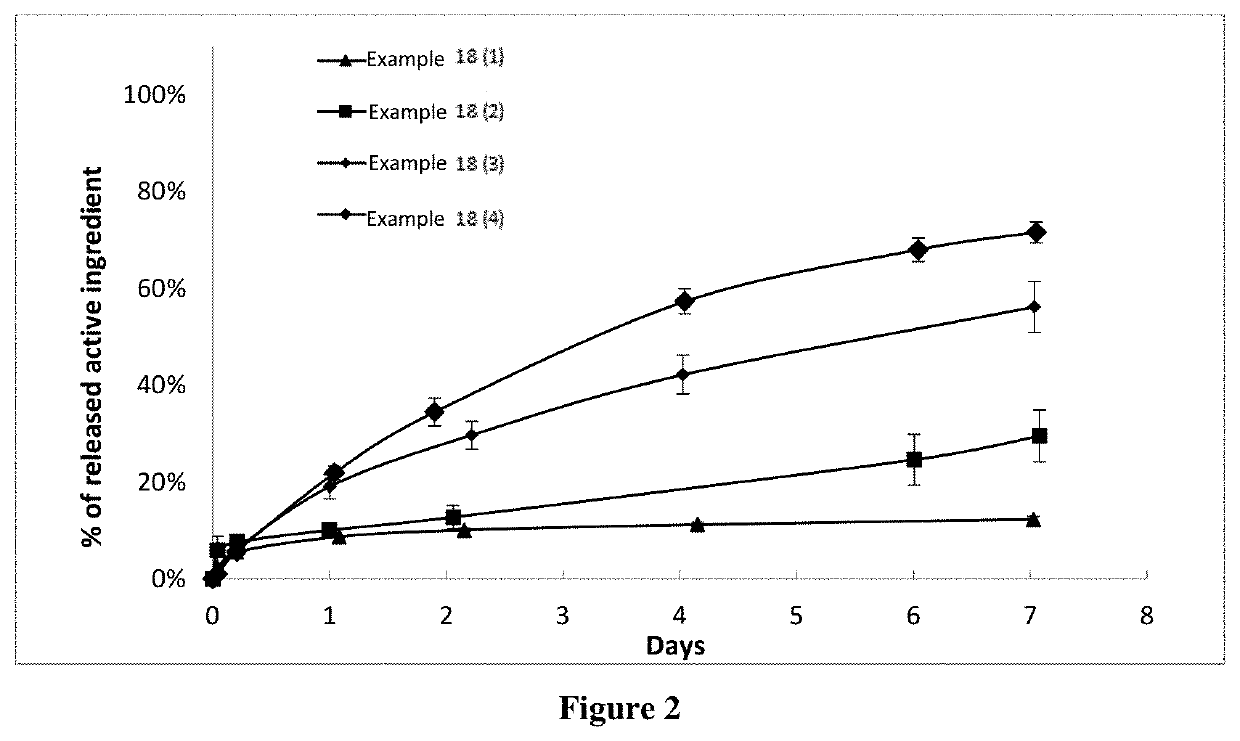Injectable prolonged-action compositions for use in the treatment of nail disease and/or for promoting nail growth
- Summary
- Abstract
- Description
- Claims
- Application Information
AI Technical Summary
Problems solved by technology
Method used
Image
Examples
example 1
[0551]4 batches of implants containing Terbinafine at different concentrations in PLGA 85:15 are prepared according to the procedure described above in A (1).
[0552]The extrusion conditions are as follows:
ScrewExtrusionExtrusionNozzleExtrusiondiameterspeedtemperaturediameteroutletBatches(mm)(rpm)(T° C.)(mm)pressure(1)86150-2100.5N / A155-162(2)810150-1700.85470-1200500-1000(mPa)(3)810-131640.590-140 bar(4)810-131660.5200-250(mPa)
[0553]Implants with a length of 10 mm and a diameter of 0.56 mm are cut out.
[0554]The batches are then evaluated analytically according to the method described above in B (1) and / or B (2).
ActiveImplantsubstanceDose of activediametercontentActivesubstance / Batches(mm)(% m / m)purity %implant (mg)(1)0.56 mm4.5098.970.15(2)0.30 mm15.7098.100.13(3)0.4029.9099.510.44(4)0.5858.2099.591.61
[0555]The In Vitro Release Test is performed as described above in B (2). The results are shown in FIG. 1.
[0556]The evaluation of the In Vitro antifungal activity is carried out as desc...
example 2
[0560]A batch of implants containing Terbinafine HCl and PLGA 85:15 is prepared according to the procedure described above in A (1).
ExtrusionScrewExtrusionExtrusionNozzleoutletdiameterspeedtemperaturediameterpressure(mm)(rpm)(T° C.)(mm)(mPa)83.5-71660.852500
[0561]Implants with a length of 25 mm and a diameter of 0.80 mm are cut out.
Dose of activeActive substanceActivesubstance / content (% m / m)purity %implant (mg)57.7099.805.70
[0562]Implants with a length of 10 mm and a diameter of 0.80 mm are cut out.
Dose of activeActive substanceActivesubstance / content (% m / m)purity %implant (mg)57.7099.802.28
[0563]The In Vitro Release Test is performed with 10 mm long implants as described above in B (2). The results are shown in FIG. 3.
[0564]The valuation of the In Vitro antifungal activity is carried out according to the method described above in C. FIG. 6 shows a picture of an agar plate after implantation of a compound according to Example 2 in Candidae Parapsilosis. The results are summarised ...
example 3
[0565]A batch of implants containing dexamethasone and PLGA 75:25 is prepared according to the procedure described above in A (1).
ExtrusionScrewExtrusionExtrusionNozzleoutletdiameterspeedtemperaturediameterpressure(mm)(rpm)(T° C.)(mm)(bar mPa)81300.8520-40
[0566]Implants with a length of 6 mm and a diameter of 0.45 mm are cut out.
Dose of activeActive substanceActivesubstance / content % m / mpurity % %implant (mg)55.099.150.646
[0567]The In Vivo test is performed as described above in E.
PUM
 Login to view more
Login to view more Abstract
Description
Claims
Application Information
 Login to view more
Login to view more - R&D Engineer
- R&D Manager
- IP Professional
- Industry Leading Data Capabilities
- Powerful AI technology
- Patent DNA Extraction
Browse by: Latest US Patents, China's latest patents, Technical Efficacy Thesaurus, Application Domain, Technology Topic.
© 2024 PatSnap. All rights reserved.Legal|Privacy policy|Modern Slavery Act Transparency Statement|Sitemap



